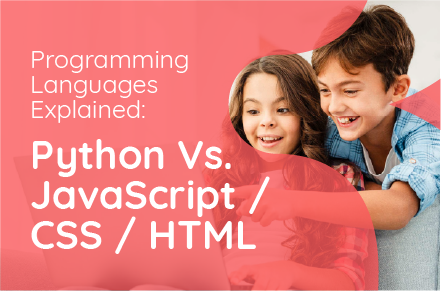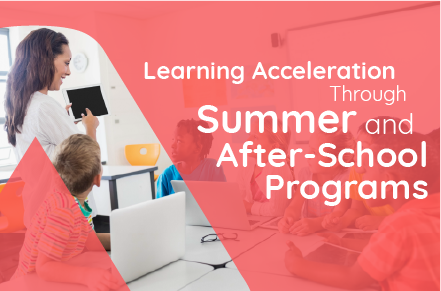The differences, similarities, and why any form of tech education is important.
You’ve likely seen Python mentioned among other traditional programming languages, including JavaScript (JS) and CSS/HTML. In fact, JavaScript, HTML/CSS, and Python all fall in the top three languages that developers use in their careers, according to the annual Stack Overflow survey (2021).
With Python’s increasing exposure, it’s important to understand how it relates to the other programming languages available, how it’s different, and provide perspective on where it fits in the classroom with your students. Let’s get started by first providing a quick overview of exactly what Python, HTML/CSS, and JavaScript are so you have a basic understanding.
Programing Languages
What is Python?
First released in 1991, Python is a general-purpose programming language that can be used in a range of applications, including data science, software development, and automation. According to Python.org, Python is an interpreted, object-oriented, high-level programming language with dynamic semantics.
The programming language has been notably used to create Netflix’s recommendation algorithm and software that controls self-driving cars, according to an article by Coursera. The Python interpreter and standard library are freely available in source or binary form for all major platforms from the Python Web site.
A fun fact about Python, creator Guido van Rossum came up with the name while reading published scripts from “Monty Python’s Flying Circus”.
What is HTML?
Hyper Text Markup Language (HTML) is a coding language used to build websites. Specifically, HTML’s job is to label and organize content such as headings, paragraphs, lists and images, so that the web browser (e.g. Chrome, Firefox, etc.) knows how the page should look.
What is CSS?
Cascading Style Sheets (CSS) is a coding language that pairs with HTML. It works by defining a series of rules for how the HTML should look (colors, spacing, etc). CSS is helpful for establishing the layout and personality of a website.
What is JavaScript?
JavaScript (JS) can be combined with HTML/CSS to bring websites to life. JavaScript is a versatile programming language that can be used for animation, dynamic apps, interactive games and more.
The Importance of Understanding a “Stack”
While JavaScript has been the most commonly used programming language for the past nine years, it’s important to mention that professional programmers are often fluent in several languages that make up what is called a “stack”.
A stack is a set of languages or frameworks that work together to accomplish common computing tasks. For example, HTML/CSS and JavaScript make up what is called a “front-end stack” because these languages are used to create what you see while on a website. Python, PHP, and SQL make up the “back-end stack” and are used to handle website databases and control how websites function with hosts and servers.
Differences and Similarities Between Programming Languages
When the question comes up, “which is better, Python or JavaScript?”, it really depends on what kind of computing tasks you might be interested in doing. Front-end developers (HTML/CSS and Javascript) spend more time working on the design, layout and the function of websites, while back-end developers (Python, PHP, and SQL) are concerned with security, networks and databases. No matter which language interests you the most, as a professional programmer you will need to study and learn the accompanying languages that make up your chosen stack.
When the question comes up, “which is better, Python or JavaScript?”, it really depends on what kind of computing tasks you might be interested in doing.
Why BSD Uses JS and HTML/CSS
At BSD Education, we feel strongly that any type of coding and digital skills instruction is vital to a student’s education and future in navigating our digital world. We have chosen the front-end stack as a part of our digital skills curriculum because it satisfies a range of interests, including design, layout, functionality, UI/UX, gaming, AI and VR. By learning three languages together to develop more interests, and ultimately more skills, students are provided a more complete learning experience that learning one language can’t match. This broad range of skills stretches beyond the keyboard and includes key computational thinking and critical thinking skills vital to learning in any other core subject.
In addition, when we think about the most powerful technologies that we use everyday, most of them operate in the web browser, which is what HTML/CSS and JavaScript are used for. Every website and web application that you have ever used were made using this front-end stack.
If students are interested in becoming computer scientists, they may need to learn Java, Python, JavaScript, or other languages depending on the accreditation program. For example, Java has been the language of choice for the Advanced Placement college equivalent course that is available in many High Schools in the U.S. Many commonly used frameworks for Computer Science do not even list a specific programming language, but instead provide a map for concepts that are found in most languages, like algorithms, variables, control structures and modularity. Both the British IGCSE and the Computer Science Teachers Association (CSTA) publish curricular guidelines and standards that focus on computer science concepts instead of specific languages.
What Fits for Your Classroom?
Ultimately when it comes to the Python versus JavaScript and HTML/CSS showdown, it really depends on what you want to do with your knowledge of programming and what goals you have as a developer.
Whether you have no experience or are ready to take your tech education to the next level, BSD provides the support and intuitive platform to help you teach these front-end stack digital skills. In a matter of minutes using BSD, students will begin building their first website, create a mobile app, or even a fun game they can play with friends. BSD makes it possible for any teacher of any subject to incorporate coding and digital skills into their curriculum so students are future ready.
Contact us today so we can address your unique needs and develop a partnership that will help your students reach further and have an experience that will equip them with the skills they will need for tomorrow, no matter what career path they choose.



